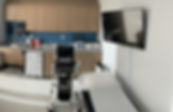Nonsurgical Meniscus Tear Treatment In Raleigh, North Carolina
Meniscus tears are among the most common knee injuries. Athletes, particularly those who play contact sports, are at risk for meniscal tears. However, anyone at any age can tear a meniscus.
What Are the Symptoms of a Meniscus Tear?
The most common symptoms of meniscal tears are:
-
Pain
-
Stiffness and swelling
-
Catching or locking of your knee
-
The sensation of your knee “giving way”
-
You are not able to move your knee through its full range of motion
Without treatment, a piece of meniscus may come loose and drift into the joint. This can cause your knee to slip, pop, or lock.


NONSURGICAL TREATMENT OPTIONS FOR MENISCUS TEARS
As with most orthopedic conditions, patients will often begin with a combination of physical therapy, anti-inflammatories, ice and rest (and in some cases, steroid injections).
When these methods are no longer effective, Carolina Nonsurgical Orthopedics offers the latest in cutting-edge treatments to reduce pain and get you back to the activities you enjoy. Some of these innovative alternatives to surgery include Orthobiologics and Regenerative Medicine treatments, such as:
-
Platelet-Rich Plasma (PRP) Injections: Use your own platelets to reduce inflammation and accelerate healing.
-
Stem Cell Injections: Use your own adipose (fat) cells to stimulate regrowth of damaged tissue (primarily beneficial for arthritis and major injuries).
-
Prolotherapy: Uses dextrose (sugar water) in place of steroid to reduce pain and promote healing.
-
Shockwave: A non-invasive therapy that uses impulses to treat chronic pain and repair tissue.
See the full list of conditions and treatments offered at Carolina Nonsurgical Orthopedics.
READ MORE ABOUT MENISCUS TEARS
Meniscus Tears: Causes, Symptoms, Diagnosis, and Treatment A meniscus tear refers to a tear in one of the two crescent-shaped cartilage structures (medial and lateral menisci) located in the knee joint. These structures play a crucial role in absorbing shock, distributing weight, and stabilizing the knee during movement. Meniscus tears are common injuries, especially in athletes, and can also occur due to normal wear and tear as people age. Understanding the causes, symptoms, diagnosis, and treatment options for meniscus tears is important for effective management and recovery. Causes of Meniscus Tears Meniscus tears can result from both acute trauma and gradual wear and tear. Acute tears often occur in younger individuals and are typically caused by twisting, pivoting, or sudden movements during sports or activities like basketball, soccer, and football. These actions can lead to an abnormal force being applied to the knee, causing the meniscus to tear. The outer part of the meniscus has a good blood supply, while the inner part has limited blood flow, making tears in the outer portion more likely to heal compared to those in the inner region. In older individuals, meniscus tears often occur due to degenerative changes associated with aging. As people get older, the meniscus can become less flexible, thinner, and more prone to damage from everyday activities such as walking or climbing stairs. This type of tear is often referred to as a degenerative meniscus tear and can develop without a specific traumatic event. Symptoms of Meniscus Tears The symptoms of a meniscus tear can vary depending on the severity and location of the tear. Common symptoms include: Knee Pain: This is often felt along the joint line and may worsen with activities that require twisting or rotating the knee, such as squatting or pivoting. Swelling: Swelling typically develops within 24 to 48 hours of the injury, especially if the tear is large or involves the blood supply. Stiffness: The knee may feel stiff or locked, making it difficult to fully extend or bend the knee. Clicking or Popping Sensation: Some individuals report a clicking or popping sound when moving the knee, which may be due to the torn meniscus moving within the joint. Instability: In some cases, the knee may feel unstable, as if it might give out, particularly when weight is placed on the affected leg. Diagnosis of Meniscus Tears To diagnose a meniscus tear, a healthcare provider will typically begin with a physical examination to assess knee movement and tenderness. Special maneuvers, such as the McMurray test, may be performed to check for meniscal damage. In some cases, the doctor may detect a clicking sound or pain when manipulating the knee, which can suggest a meniscus tear. Imaging tests, such as magnetic resonance imaging (MRI), are commonly used to confirm the diagnosis and assess the severity and location of the tear. An MRI provides detailed images of soft tissues, including the meniscus, and is effective in identifying tears that may not be visible on X-rays. In some cases, if the tear is complex or not clearly visible on MRI, an arthroscopy (a minimally invasive surgical procedure) may be used to directly visualize the meniscus and make a definitive diagnosis.


WHY CAROLINA
NONSURGICAL ORTHOPEDICS
-
All Providers are BOARD CERTIFIED and Specially Trained in Nonsurgical Orthopedics
-
Over 50,000+ and Counting Procedures Performed
-
Procedures Performed with Ultrasound Guidance for Accuracy and Safety
-
Local and Independent Practice That is NOT a Franchise
-
Discounts for Service Members, Teachers, and Public Servants
-
Serving Raleigh Since 2013
.png)

